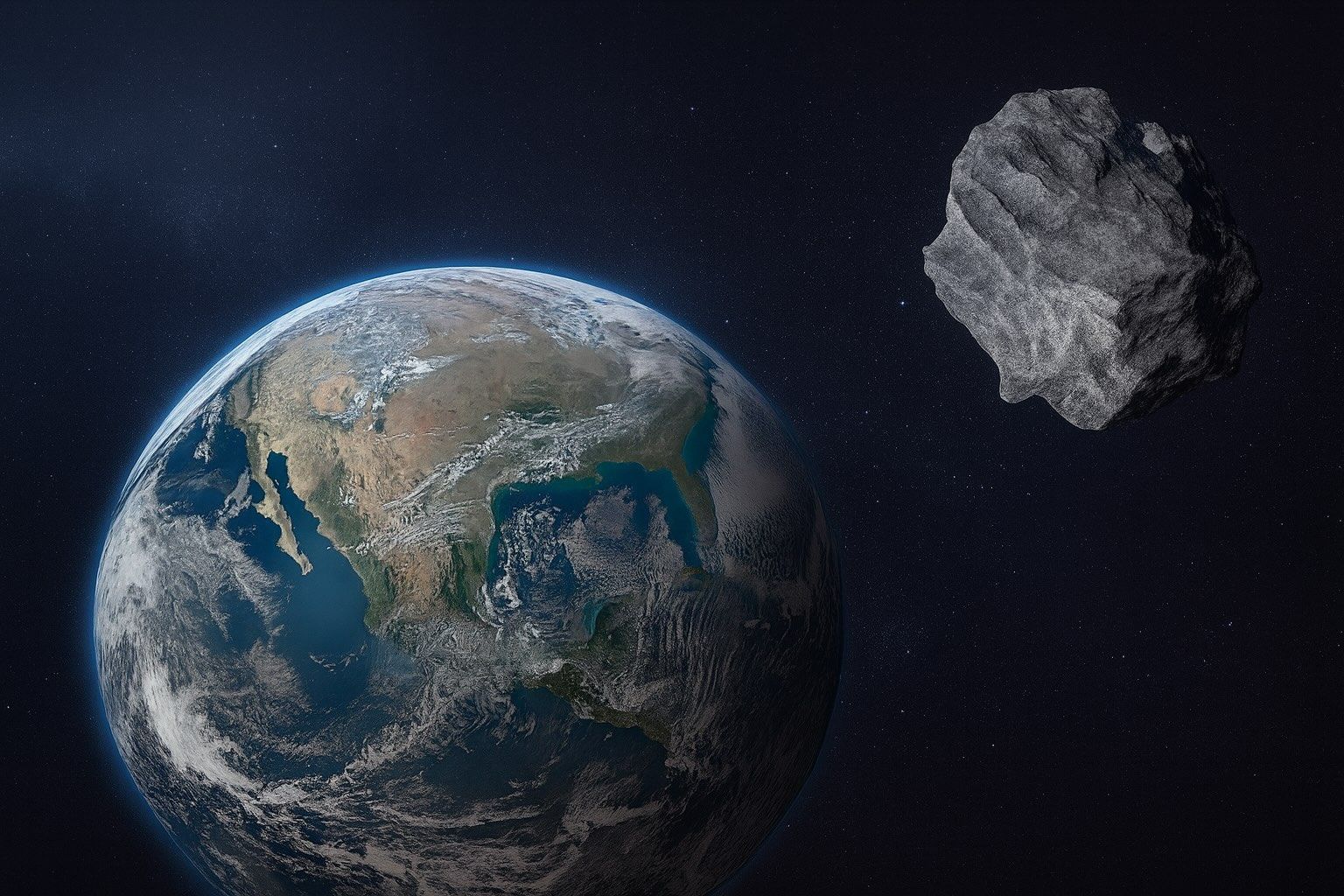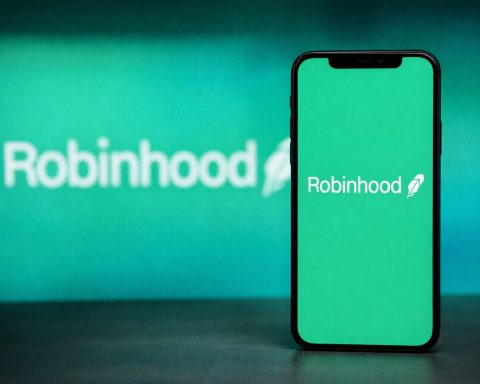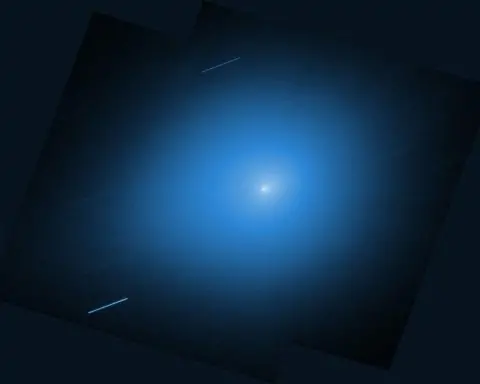- Tiny Asteroid Co-Orbits Earth: Astronomers report that asteroid 2025 PN7, a small 19-meter (62-ft) rock, has been “co-orbiting” Earth for decades like a second moon [1] [2]. NASA and partners confirm it shares Earth’s orbital path, earning the title of a “quasi-moon” or “mini-moon” [3] [4].
- Discovery & Orbit: 2025 PN7 was first spotted on Aug 2, 2025 by the Pan-STARRS telescope in Hawaii [5]. Analysis of archived data shows it entered Earth’s resonant path in the 1960s and will remain near our planet for roughly 60 more years [6] [7]. It orbits the Sun in lockstep with Earth (a 1:1 resonance), so from our point of view it seems to “loop” around Earth [8] [9].
- Not a True Moon: Scientists stress PN7 is not a true second Moon. Unlike our Moon (which is gravitationally bound to Earth), PN7 orbits the Sun [10] [11]. It only appears to follow Earth because of its synchronized path. As one report explains: “Unlike the Moon, which is locked in Earth’s gravity, this rock is really orbiting the Sun. But from Earth’s perspective, it appears to loop around us like a second moon” [12].
- Size & Safety: At just ~19 m across (roughly a city bus) [13], PN7 is extremely small. It never comes closer than about 4 million km – ten times the distance to our Moon – so it poses no threat [14]. In fact, by NASA’s criteria only asteroids larger than ~150 m passing within ~4.65 million miles are classed as “potentially hazardous” [15]. Experts agree PN7 is far below that threshold and “the answer is no” to any collision risk [16] [17].
- Other Quasi-Moons: Earth has hosted several similar “quasi-satellites” before. Well-known examples include Asteroid 469219 Kamoʻoalewa (2016 HO3) and 2023 FW13 [18] [19]. A recent study lists at least seven such objects. 2025 PN7 is now the newest member of this club [20]. However, NASA emphasizes Earth’s only official moon remains the large natural Moon, and PN7 is a temporary companion, not a true second Moon [21].
NASA Announces New “Quasi-Moon” Discovery
On Oct 22, 2025, space agencies worldwide celebrated the announcement that Earth has a new celestial companion. A team from the University of Hawaii’s Pan-STARRS survey discovered a tiny asteroid – designated 2025 PN7 – on Aug. 2, 2025, and subsequent orbit analysis showed it has been silently trailing Earth for roughly 60 years [22]. NASA confirmed in a press report that this 62-foot-wide rock is Earth’s newest “quasi-moon,” meaning it is not a bound satellite but a co-orbital asteroid [23] [24]. As one global space news outlet noted, astronomers “confirmed a tiny ‘quasi-moon’ – asteroid 2025 PN7 – has been co-orbiting Earth for decades” [25].
Astronomers used NASA’s Jet Propulsion Laboratory (JPL) tools to study its path. The orbit of PN7 is unusual: it is in a 1:1 resonance with Earth, completing one solar orbit in the same time as Earth (about one year) [26]. From our viewpoint it “keeps pace” with Earth, appearing to loop around our planet. NASA models predict 2025 PN7 will continue this synchronized dance until about 2083, when perturbations will finally nudge it away [27] [28].
What Exactly Is a “Quasi-Moon”?
Experts clarify that PN7 is not a second Moon in the conventional sense. It never enters Earth’s gravitational grip. Instead, it shares a solar orbit nearly identical to Earth’s. As the Chron news service explains, 2025 PN7 “is orbiting the Sun, just like Earth, but it keeps pace with us so closely that it seems to loop around our planet” [29]. This “horseshoe” or quasi-satellite orbit is a known orbital configuration. In fact, NASA’s statement was careful to note that Earth’s only true Moon remains the one we see in our night sky. The asteroid’s behavior earned it the label “quasi-satellite” because it only appears to circle Earth [30] [31].
In technical terms, 2025 PN7 belongs to the Arjuna class of near-Earth asteroids: a rare group whose orbits are very similar to Earth’s (same distance from the Sun, low tilt, low eccentricity) [32]. Some scientists even call these objects a “secondary asteroid belt” near Earth. Carlos and Raúl de la Fuente Marcos (Complutense University, Madrid) led a study mapping 2025 PN7’s path. Using JPL’s HORIZONS system, they confirmed it has been in this co-orbital arrangement for about 60 years, and will remain for roughly 60 more [33]. “The object’s orbit shifts from a horseshoe shape to a quasi-satellite loop,” the researchers note, illustrating why it was invisible until now [34] [35].
No Threat to Earth’s Safety
Crucially, 2025 PN7 poses no danger to Earth. The asteroid’s path never brings it anywhere near collision distance. It always stays millions of kilometers out: about 4,000,000 km away at closest approach [36]. To put that in perspective, the Moon orbits at ~384,000 km, so PN7 is at least ten times farther away. Experts emphasize that such a small, distant rock cannot affect us. The Economic Times summarized: “2025 PN7 never comes closer than about 4 million kilometers…so it poses no threat to Earth and has no impact on tides, gravity or day-to-day life” [37].
In fact, by NASA’s hazard criteria an object must be much larger to be a concern. Only asteroids over ~150 meters wide passing within ~4.65 million miles are tagged “potentially hazardous” [38]. PN7, at just ~19 m, is orders of magnitude smaller. As a leading space analyst points out, their models show “2025 PN7 has been in this strange orbit for about 60 years…one of the first questions asked was whether it poses any risk to Earth. The answer, for now, is no” [39] [40]. In short, PN7’s only influence is scientific: it serves as a natural “experiment” for understanding how tiny asteroids behave near our planet, not as a threat.
Other “Mini-Moons” and Why It Matters
This discovery adds to a small family of Earth’s temporary companions. Astronomers have identified at least seven other quasi-satellites in recent years [41] [42] – for example, 469219 Kamo‘oalewa (2016 HO3) and 164207 Cardea (2004 GU9) [43]. None of these were Earth’s actual moons; rather they are loose co-orbiters that come and go on multi-decade timescales. The Hindustan Times notes PN7 “is not a second moon in the true sense, but it travels so closely with our planet that it has earned an honorary title” [44].
Adding PN7 to the list broadens scientists’ view of this phenomenon. The de la Fuente Marcos team calculated that 2025 PN7’s quasi-satellite phase will last ~128 years – relatively short compared to Kamo‘oalewa’s ~381-year stint [45]. As one astronomer put it, Earth’s new companion “offers a rare window into how small asteroids can temporarily join Earth’s journey around the Sun” [46]. In other words, every such discovery helps refine our understanding of orbital dynamics and improve asteroid tracking. Indeed, NASA’s Planetary Defense program stresses that monitoring even harmless co-orbitals sharpens the techniques used to spot any future dangerous near-Earth objects [47] [48].
What Astronomers Say
Scientists involved emphasize that 2025 PN7 was simply too dim and infrequently visible to be spotted earlier. “It is small, faint, and its visibility windows from Earth are rather unfavorable, so it is not surprising that it went unnoticed for that long,” notes Carlos de la Fuente Marcos [49]. No other clues about its origin are evident: whether it drifted in from the asteroid belt or broke off from a past collision remains speculation [50].
In summary, this tiny asteroid is a scientific curiosity, not a crisis. Its discovery made headlines because it’s unusual for Earth to gain any companion, but experts quickly point out there is no cause for alarm. NASA and astronomers alike have reiterated that Earth’s official moon count remains one, with 2025 PN7 merely a temporary cosmic tag-along [51] [52]. For now, it will quietly trace its loop for decades, and astronomers will watch its path closely – both out of curiosity and as practice for defending against any truly hazardous space rocks in the future [53] [54].
Sources: News reports and expert analyses from NASA-related articles and observatories [55] [56] [57] [58]. (Additional background from Hindustan Times, Chron, and science outlets.)
References
1. ts2.tech, 2. www.hindustantimes.com, 3. ts2.tech, 4. www.hindustantimes.com, 5. www.chron.com, 6. www.chron.com, 7. economictimes.indiatimes.com, 8. www.chron.com, 9. www.thebrighterside.news, 10. economictimes.indiatimes.com, 11. www.thebrighterside.news, 12. www.thebrighterside.news, 13. www.thebrighterside.news, 14. economictimes.indiatimes.com, 15. ts2.tech, 16. economictimes.indiatimes.com, 17. www.thebrighterside.news, 18. www.hindustantimes.com, 19. www.chron.com, 20. www.hindustantimes.com, 21. economictimes.indiatimes.com, 22. www.chron.com, 23. ts2.tech, 24. www.hindustantimes.com, 25. ts2.tech, 26. www.chron.com, 27. economictimes.indiatimes.com, 28. www.chron.com, 29. www.chron.com, 30. economictimes.indiatimes.com, 31. www.thebrighterside.news, 32. www.chron.com, 33. www.thebrighterside.news, 34. www.chron.com, 35. www.thebrighterside.news, 36. economictimes.indiatimes.com, 37. economictimes.indiatimes.com, 38. ts2.tech, 39. www.thebrighterside.news, 40. www.thebrighterside.news, 41. www.hindustantimes.com, 42. www.thebrighterside.news, 43. www.hindustantimes.com, 44. www.thebrighterside.news, 45. www.thebrighterside.news, 46. www.chron.com, 47. www.thebrighterside.news, 48. economictimes.indiatimes.com, 49. www.thebrighterside.news, 50. economictimes.indiatimes.com, 51. economictimes.indiatimes.com, 52. www.thebrighterside.news, 53. www.thebrighterside.news, 54. www.chron.com, 55. economictimes.indiatimes.com, 56. www.chron.com, 57. www.thebrighterside.news, 58. www.thebrighterside.news










